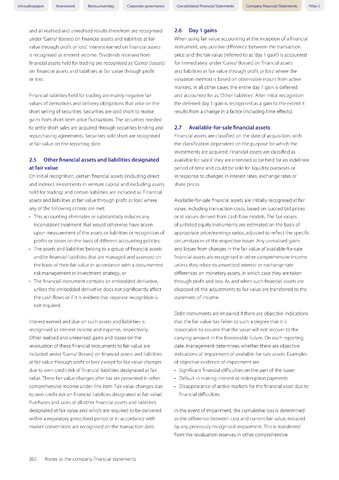Inhoudsopgave Voorwoord Bestuursverslag Corporate governance
Consolidated Financial Statements Company Financial Statements Pillar 3
and all realised and unrealised results therefrom are recognised
under 'Gains/ (losses) on financial assets and liabilities at fair
value through profit or loss'. Interest earned on financial assets
is recognised as interest income. Dividends received from
financial assets held for trading are recognised as 'Gains/ (losses)
on financial assets and liabilities at fair value through profit
or loss'.
Financial liabilities held for trading are mainly negative fair
values of derivatives and delivery obligations that arise on the
short selling of securities. Securities are sold short to realise
gains from short-term price fluctuations.The securities needed
to settle short sales are acquired through securities lending and
repurchasing agreements. Securities sold short are recognised
at fair value on the reporting date.
2.5 Other financial assets and liabilities designated
at fair value
On initial recognition, certain financial assets (including direct
and indirect investments in venture capital and excluding assets
held for trading) and certain liabilities are included as 'Financial
assets and liabilities at fair value through profit or loss' where
any of the following criteria are met:
This accounting eliminates or substantially reduces any
inconsistent treatment that would otherwise have arisen
upon measurement of the assets or liabilities or recognition of
profits or losses on the basis of different accounting policies;
The assets and liabilities belong to a group of financial assets
and/or financial liabilities that are managed and assessed on
the basis of their fair value in accordance with a documented
risk management or investment strategy; or
The financial instrument contains an embedded derivative,
unless the embedded derivative does not significantly affect
the cash flows or if it is evident that separate recognition is
not required.
Interest earned and due on such assets and liabilities is
recognised as interest income and expense, respectively.
Other realised and unrealised gains and losses on the
revaluation of these financial instruments to fair value are
included under 'Gains/ (losses) on financial assets and liabilities
at fair value through profit or loss' except for fair value changes
due to own credit risk of financial liabilities designated at fair
value. These fair value changes aftertax are presented in other
comprehensive income under line item 'Fair value changes due
to own credit risk on financial liabilities designated at fair value'.
Purchases and sales of all other financial assets and liabilities
designated at fair value and which are required to be delivered
within a regulatory-prescribed period or in accordance with
market conventions are recognised on the transaction date.
2.6 Day 1 gains
When using fair value accounting at the inception of a financial
instrument, any positive difference between the transaction
price and the fair value (referred to as 'day 1 gain') is accounted
for immediately under'Gains/ (losses) on financial assets
and liabilities at fair value through profit or loss'where the
valuation method is based on observable inputs from active
markets. In all other cases, the entire day 1 gain is deferred
and accounted for as 'Other liabilities'. After initial recognition
the deferred day 1 gain is recognised as a gain to the extent it
results from a change in a factor (including time effects).
2.7 Available-for-sale financial assets
Financial assets are classified on the date of acquisition, with
the classification dependent on the purpose for which the
investments are acquired. Financial assets are classified as
available for sale if they are intended to be held for an indefinite
period of time and could be sold for liquidity purposes or
in response to changes in interest rates, exchange rates or
share prices.
Available-for-sale financial assets are initially recognised at fair
value, including transaction costs, based on quoted bid prices
or at values derived from cash flow models.The fair values
of unlisted equity instruments are estimated on the basis of
appropriate price/earnings ratios, adjusted to reflect the specific
circumstances of the respective issuer. Any unrealised gains
and losses from changes in the fair value of available-for-sale
financial assets are recognised in other comprehensive income
unless they relate to amortised interest or exchange rate
differences on monetary assets, in which case they are taken
through profit and loss. As and when such financial assets are
disposed of, the adjustments to fair value are transferred to the
statement of Income.
Debt instruments are impaired if there are objective indications
that the fair value has fallen to such a degree that it is
reasonable to assume that the value will not recover to the
carrying amount in the foreseeable future. On each reporting
date, management determines whether there are objective
indications of impairment of available-for-sale assets. Examples
of objective evidence of impairment are:
Significant financial difficulties on the part of the issuer
Default in making interest or redemption payments
Disappearance of active markets for the financial asset due to
financial difficulties.
In the event of impairment, the cumulative loss is determined
as the difference between cost and current fair value, reduced
by any previously recognised impairment.This is transferred
from the revaluation reserves in other comprehensive
265 Notes to the company financial statements

